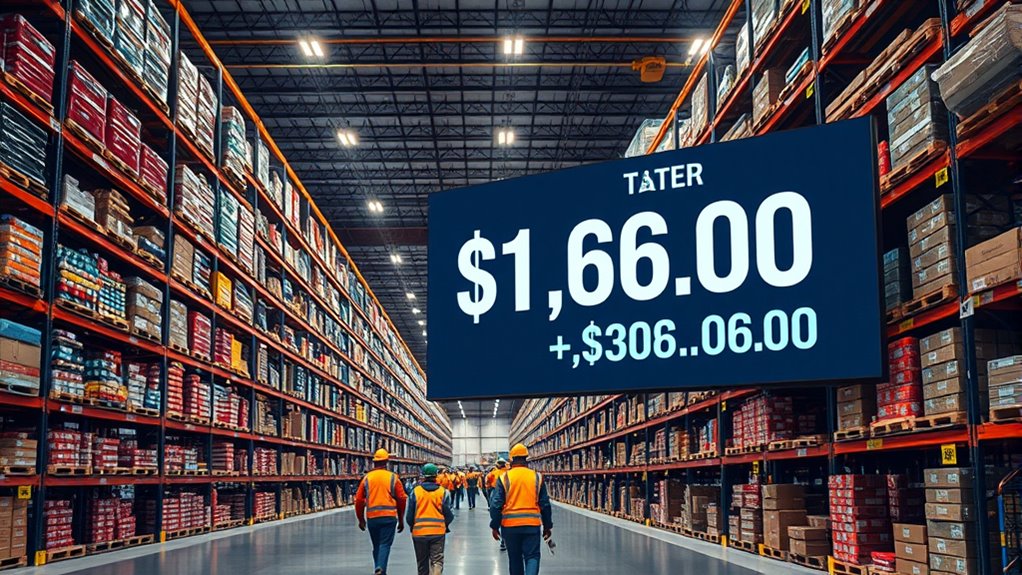Amazon invested over $1 billion in 2025 to raise wages for U.S. workers, showing its strong commitment to pay competitiveness and employee retention. Wages in fulfillment and transportation roles now average over $23 per hour, with total compensation exceeding $30 when benefits are included. Employees can see wage increases of about 35% over several years, aligning with industry standards. Keep exploring to learn more about how Amazon supports its workforce and offers competitive pay.

Amazon invests heavily in its workforce, committing over $1 billion in 2025 to wage increases for U.S. fulfillment and transportation employees. This substantial investment shows Amazon’s dedication to paying competitive wages and retaining staff during peak shopping seasons like Prime Day and the holidays. As a result, your pay in these roles has risen considerably, with the average hourly wage now exceeding $23, and when benefits are included, total compensation surpasses $30 per hour. These pay hikes aren’t just one-time boosts; they include annual progression raises that reward your loyalty and help you grow within the company. If you stay with Amazon for a few years, particularly in fulfillment or transportation, you can see your wages increase by about 35%, reflecting Amazon’s focus on long-term employee retention. Salary data and market trends show that these increases are aligned with broader industry standards to ensure competitive compensation. Across Amazon, the average salary is roughly $97,717 annually, but this varies widely depending on your role and experience. Warehouse workers might earn around $36,324 per year, while software development managers can bring home as much as $167,499. Entry-level work-from-home positions average about $90,674 annually, or roughly $43.59 per hour in 2025. For highly specialized roles, salaries can climb even higher—software engineers, for example, can make up to $263,700 each year, and data scientists earn approximately $230,900. These figures include not just base pay but also additional components like equity grants, signing bonuses, and benefits. Equity is vested over four years, with staggered vesting (5%, 15%, 40%, 40%) to incentivize long-term commitment. Signing bonuses typically range from $60,000 to $80,000, providing an immediate boost to your initial compensation package. Amazon offers more than just a paycheck. You benefit from perks like 401(k) matching, tuition assistance, and healthcare plans that can cost as little as $5 per week with $5 copays for entry-level employees. As part of the package, you also get a free Prime membership, which adds value through free shipping, streaming, and other services. Women, men, and non-binary employees all earn competitive salaries, but notable gender pay gaps exist—men earn around $260,000 annually, women about $216,000, and non-binary employees approximately $228,000. Amazon also recruits highly skilled foreign workers through the H-1B visa program, where salaries for tech roles like software engineers and data scientists can reach up to $263,700 and $230,900, respectively. These salaries reflect Amazon’s push to hire top talent globally, filling specialized roles with highly qualified professionals. Overall, Amazon’s substantial wage investments and all-encompassing benefits aim to keep its workforce motivated, skilled, and ready to support the company’s growth. Furthermore, the company’s commitment to competitive wages aligns with its strategy for retaining skilled labor in a competitive market.
Frequently Asked Questions
How Does Amazon Determine Wage Differences Across Regions?
Amazon determines wage differences across regions by reviewing local market rates annually and adjusting wages to stay competitive. You’ll find starting pay varies based on location, with adjustments for regional cost of living and median income. The company also considers legal frameworks and collective bargaining agreements, especially in Europe. Temporary pandemic-related pay raises were added to address specific economic needs, but regional wage structures primarily guide pay differences.
Are Amazon Wages Adjusted for Inflation Annually?
You might think Amazon adjusts wages annually for inflation, but it’s not that straightforward. While wages increase regularly, they’re mainly tied to market competitiveness and retention rather than inflation rates directly. Benefits like healthcare and Prime memberships add value, cushioning inflation’s impact. So, your pay might not rise solely because of inflation, but Amazon’s overall compensation strategy aims to keep your earnings competitive and your living costs manageable.
What Benefits Are Included Alongside Amazon Employee Wages?
You receive a complete package of benefits alongside your wages at Amazon. These include medical, dental, and vision coverage, paid life and accident insurance, and specialized cancer support through Amazon CARES. You also get paid parental leave, flexible time off, and access to financial tools like 401(k) matching and RSUs. Additionally, there are wellness programs, mental health resources, and support for family care, all designed to support your overall well-being.
How Do Amazon Wages Compare to Industry Standards?
Like a knight of yore, you’ll find Amazon wages generally competitive. Fulfillment workers earn $22+ per hour, with total benefits pushing that above $29. These wages beat many retail and logistics roles, which typically pay $15-$20. Corporate salaries, including stock options and bonuses, also hold their ground in the industry. While tech salaries vary, Amazon’s pay structure supports retention and growth, making it a strong contender in industry standards.
Do Amazon Wages Vary Between Full-Time and Part-Time Workers?
Yes, Amazon wages differ between full-time and part-time workers. You’ll find full-time employees earn steady salaries with full benefits, typically working over 40 hours a week. Part-time workers often earn higher hourly rates or bonuses to compensate for fewer hours and limited benefits. Seasonal workers also get above-minimum wages during peak times. These differences reflect Amazon’s strategy to balance flexibility, compensation, and benefits across employment types.
Conclusion
All these wages are like a tidal wave, shaping the landscape of jobs and livelihoods. Amazon’s investment isn’t just a drop in the ocean—it’s a relentless current powering countless lives forward. As you see this financial surge, remember it’s more than numbers; it’s a symphony of effort and opportunity, flowing together to build a future where workers ride the waves of growth. The impact is vast, and you’re right in the heart of it.









